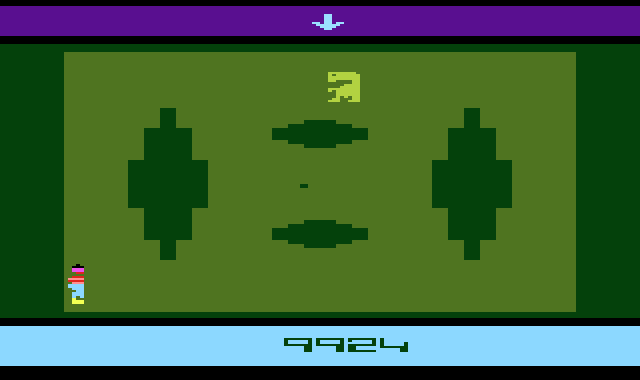
History of Video Games: The Rise of an Industry (1973-1982) - Article
by Taneli Palola , posted on 03 February 2016 / 16,267 ViewsThis article is the second part of a comprehensive look at the history of video games from its humble origins to the present day. You can find the first piece here. As we move forward in time I will cover an increasingly shorter period of time with each article simply because there is so much more to talk about the closer we get to the present day.
We ended the first part of this look at the history of video games at the threshold between two eras. The first video and arcade games had been born and the development of video games was rapidly accelerating. The foundations had been set, now someone just had to build upon them and push the industry into a new age. That someone would turn out to be a man already mentioned in the previous article, Ralph Baer.

In 1968 Baer had patented his idea for an interactive television game and finally in 1972 his idea would come to fruition. In August of that year the Magnavox Odyssey was released, becoming the first ever commercial home video game console. The console played games through printed circuit boards called “game cards”, which didn't actually contain any games, but instead they sent electronic signals to the console itself which would then produce the desired game and video screen.
The Odyssey would become a moderate success, selling roughly 330,000 units until it was discontinued in 1975. However, it wasn't the only notable release of 1972. Magnavox may have been somewhat successful, but the true revolution began in November 1972, when the recently-founded Atari would release its first arcade game, Pong.
The idea for Pong came when Nolan Bushnell saw a demonstration for the Magnavox Odyssey, specifically its table tennis game. After that, Bushnell told Atari engineer Allan Alcorn to make an arcade version of the game, which would ultimately become the game that we all know today. After its release it didn't take long for other companies to start copying the game and producing their own versions of it, which in turn prompted Atari to begin creating more complex and innovative games.
With these two, the video game industry was effectively born. The first console generation began with the Odyssey and arcade gaming also took its first serious steps towards a golden age. However, for a while the large number of copycats kept arcade gaming in check, preventing it from growing until much later in the decade. In the meanwhile, home consoles were also in a bit of a lull. The Odyssey was the only actual home console on the market for a very long time, as any potential competitors had to start developing them from scratch given that the success of the Odyssey came as a complete surprise.
1973 was something of a quiet year in terms of video games, but several companies that would later become important for gaming were established or entered the video game industry. Konami and Hudson Soft were established in Japan, and Sega and Taito made their first forays into making arcade games. The industry continued to be dominated by a single gaming console and numerous copies of Pong keep being made by various different developers, including the aforementioned Taito.

In 1974 the industry continued to grow and became more of a worldwide endeavour, with Japanese companies gaining more and more traction and Namco entering the arcade gaming business. Magnavox Odyssey would also spread to a larger audience after it is released in various European countries, as well as Australia and Venezuela. Also, while computers weren't very widely available at the time, numerous new computer games were still being developed around the world. One notable example from 1974 is Maze War, which is considered the precursor to modern first-person shooters. Another game called dnd was also released that same year and it has the distinction of having the first ever video game boss, as well as being arguably the first ever role-playing video game.
Following two relatively slow years, 1975 is when the video game industry began to truly take shape. While the original Odyssey would be discontinued, Magnavox would introduce several new versions of the console from this year onwards. In addition, Magnavox would for the first time face serious competition in the home console market from several different companies. In Japan, Epoch would release the first ever Japanese home console, the TV Tennis Electrotennis, and in Britain Binatone would release the Binatone TV Master. However, the main reason 1975 is an important year in the history of video games is due to the release of Atari's Home Pong in December.
The home version of Pong would become a phenomenon in a very short amount of time, even with a limited initial release of 150,000 units, all of which were sold during its first holiday season. As a result it became the fastest selling home console up to that point.

The first generation of consoles was already beginning to wind down at this point. In 1976 only one new first generation console was released, the Coleco Telstar, and last first generation console was introduced in 1977. However, this last console was very significant for one specific reason. It was the first ever console produced by a certain Japanese company that would later change the industry for good. Yep, we finally get to Nintendo. Nintendo's first console was called the Color TV-Game and 5 different versions of it were released over the next several years. It ultimately went on to become the most successful first generation console with 3 million units sold.
Interestingly, while the first console generation lasted at least until 1978, and even longer in some parts of the world, the second console generation had already begun back in 1976, less than a year after the release of Home Pong. 1976 would also see the release of a number of important video games, most notably Atari's Breakout and what is perhaps the first ever adventure game and a precursor to modern role-playing games, Adventure. 1976 may also be the first time that a video game caused a public outcry. The game in question was Death Race, which was considered so violent at the time that it actually triggered an investigation on the psychological impact of video games by the news program 60 Minutes. Take a look and judge for yourself.
As has already been mentioned, the second console generation began in 1976 and it was with the release of Fairchild Channel F. The Channel F has the distinction of being the first console to use Rom-based cartridges which would soon become the industry norm. While it was indeed the first of its generation, the console ultimately failed to become a success before other manufacturers started bringing their own consoles to the market and this left the Channel F being more of a curiosity than anything else. It was quickly overshadowed by its contemporaries which were generally more advanced or just marketed better.

The Channel F did end up influencing the rest of the generation in a very significant way. At the time Atari's Pong was beginning to lose momentum, and although Atari was already working on a new console with a similar cartridge based system, the release of a competitor at such an early point spurred Atari into releasing the console much earlier than originally intended. Atari was worried that the market would be flooded by cartridge based systems before they could release their own console, and as such the new console was pushed to completion in September 1977 and released as the Atari Video Computer System. Of course, today we all know that console as the Atari 2600.

The 2600 became the most successful home console ever released and would hold that distinction for some time. By the end of its impressively long lifespan (it was discontinued in 1992) the console had sold around 30 million units, which is 10 times the number of the second highest selling console of its generation.
1977 would also see the release of another console, the Bally Astrocade, but this would end up being little more than a footnote in video game history. The year wasn't all about new hardware though. At this point the industry was growing by leaps and bounds, and more and more games were being released every year. Perhaps most notably the first version of the classic text-based adventure game Zork was created this year.
The following year would see the release of one of the most influential arcade games of all time - Taito's Space Invaders. The arcade game was so popular that it actually caused a shortage of 100-yen coins in Japan. Midway would bring the game to the United States in October, marking the start of the golden age of arcade games. Following the success of Taito's arcade classic, numerous developers would enter the arcade market with their own games. These companies included such names as Nintendo, Namco, and Konami.
This year also marked the first time the American arcade market exceeded $1 billion in revenue. This success subsequently led to the birth of video game journalism aimed at consumers. Several new consoles were released as well, but none of them found any significant success. As a result Atari still reigned supreme on the home console front.
Beginning in 1979 the video game industry would enter an unprecedented boom period with both consoles and arcades reaching huge audiences all around the world. In arcades, games like Galaxian and Asteroids generated a lot of excitement, while at home Atari's Adventure played with people's imaginations.
1979 featured the first widely known easter egg in a video game, when the Adventure's developer included a secret room that contained a short text crediting him as the game's creator. The reason behind this was Atari's policy of not including the names of the people who made their games in the credits because they were worried other companies would poach their talent. The game's creator, Warren Robinett, found a way around this, and in the process just happened to make history.

The first signs of real competition to Atari's dominance also appeared in 1979, when Mattel test marketed its then upcoming console, the Intellivision. It would launch nationwide in the U.S in 1980 and became the second best selling console of its generation with sales of 3 million units. The Intellivision was technologically superior to the 2600 and had better graphical capabilities, giving it an edge over Atari's rapidly aging console. It was effectively the first and arguably only serious threat to Atari during the second console generation.
The year would also see some other notable events occur. For example, Richard Garriot released his first complete game in 1979. Akalebeth: World of Doom is considered a precursor to his Ultima-series which would make Garriot one of the most well-known game creators of all time.
The start of the 1980's pushed video games to even greater heights than ever before. Arcade business was soaring and home consoles were showing no signs of slowing down either. Video games were becoming one of the most lucrative fields of entertainment and in 1980 they became a genuine popculture phenomenon with the help of a certain arcade game starring a yellow ball with a mouth and four ghosts.
In May of 1980 Pac-Man was released in Japan to a somewhat lukewarm response, leading to its distributors in the west having low expectations for the game. Because of this, everyone was completely unprepared for the level of success the game immediately achieved among the general public. It would quickly become the highest grossing video game of all time at that point, passing other highly successful games like Asteroids and Space Invaders in revenue.
Outside of the arcades Nintendo was about to take control of the handheld market with a little device created by one Gunbei Yokoi - Game & Watch. The Game & Watch series would go on to sell over 40 million units across 60 different variations during the next 11 years, until it was finally discontinued in 1991.

As far as hardware is concerned, 1981 was largely uneventful, but it was anything but that for new video games. In arcades players got their hands on Namco's Galaga, Konami released Frogger, and Nintendo introduced a game that put them on the path to become the most dominant force in the industry - Donkey Kong. In it players were for the first time introduced to both Donkey Kong and Mario (still known as Jumpman at the time), and it is also the game that truly launched the career of Shigeru Miyamoto.
At home both consoles and computers received numerous highly influential and successful titles, many of which spawned multipart series that are still going on today. The RPG genre made a huge leap forward with the releases of both the first Ultima and Wizardry. Castle Wolfenstein began the long-running series with a top-down stealth game. 1981 can also be considered to mark the true beginnings of video game journalism, when the first magazines dedicated solely to video games were founded. The first of these were Computer and Video Games in the UK and Electronic Games in the US.

The following year console manufacturers would come back with a vengeance, as a slew of new consoles were released in 1982. Even disregarding most of the less popular ones, potential gamers were still left with the Atari 5200, the ColecoVision, the Arcadia, and the Vectrex to choose between, all of which were vying for space in the increasingly crowded market. While the industry was still growing at this point, the abundance of home consoles would soon begin to oversaturate the market.
1982 was still a time of great growth for the industry. New companies were being founded all the time, including Electronic Arts and Lucasfilm Games, among countless others. A staggering number of new games were released, contributing to 1982 becoming the biggest year in video game history. The list of classic games that were released includes, but is not even close to limited to: Ms.Pac-Man, Dig Dug, Donkey Kong Jr., Q*Bert, Joust, Pitfall!, Ultima II, the 2600 version of Pac-Man, and what is perhaps the most infamous game of all time, E.T: The Extra Terrestrial for the 2600. The industry was still doing huge business, but the first signs of an impending fall were already in the air.

The year would also see the release of three hugely popular home computers - the Commodore 64 in mainland Europe, ZX Spectrum in the UK, and NEC PC-98 in Japan. Home computer gaming in general was largely immune to the oversaturation of the market happening in the console market. As such, the events that would begin to unfold in 1983 left them, and the European and Japanese markets, mostly unscathed.
This is a good place to end the second part of this look at the history of video games. The next part will cover the sad end to the second console generation and the ascent of a new titan in the gaming world.
More Articles
Both articles are great, but I understand the Jumpman note is an error that's widely accepted. He had been named Mario before the cabinets shipped.
I love these mini essay-like articles. Shows a large chunk of video game history in a few pages
Thanks. It's nice to know people like these.
Big failure! ET was NOT the worst game. This is the biggest fairy tale in videogames history! Atari has sold more ET cartridges than PacMan Cartridges! (But yes, Atari throw millions of ET Cartridges away) And this is why i hate those mini articles. They are too short for the truth and all details.
This is great! A+
Great work! I love reading about the history of games and consoles.






















